Air Jordan
Air Jordan is a brand of basketball shoes, athletic, casual, and style clothing produced by Nike. It was created for former NBA player and six-time NBA Finals MVP Michael Jordan. The original Air Jordan sneakers were produced exclusively for Michael Jordan in early 1984, and released to the public in late 1984. The shoes were designed for Nike by Peter Moore, Tinker Hatfield, and Bruce Kilgore.
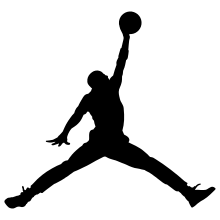 The silhouette of Michael Jordan served as inspiration to create the "Jumpman" logo. | |
| Product type | Footwear, clothing |
|---|---|
| Owner | Nike, Inc. |
| Country | United States |
| Introduced | November 17, 1984[lower-alpha 1] |
| Markets | Worldwide |
| Website | Air Jordan at Nike |
Product history
Air Jordan
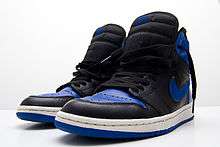
The Air Jordan that was first produced for Michael Jordan in 1984 was designed by Peter C. Moore.[2] The red and black colorway of the Nike Air Ship, the prototype for the Jordan I, was later outlawed by then-NBA Commissioner David Stern for having very little white on them (this rule, known as the "51 percent" rule, was repealed in the late 2000s[3]).[4] After the Nike Air Ship was banned, Michael Jordan and Nike introduced the Jordan I in colorways with more white, such as the "Chicago" and "Black Toe" colorways. They used the Nike Air Ship's ban as a promotional tool in advertisements, hinting that the shoes gave an unfair competitive advantage. The Air Jordan I was originally released from 1985 to 1986, with re-releases (known as "retros") in 1994, 2001–2004, and 2007 to the present.
Some released colorways include:
- Black/Red: September 15, 1985
- White/Black-Red: September 15, 1985
- Black/Royal Blue: 1985
- White/Blue: 1986
- Pewter/Black Max-Orange: January 31, 2009
- White/Sea Green: July 4, 2009
- Black/Shadow Grey-White: September 1, 2009
- Wolf Grey/Spice White: July 1, 2010
- Metallic Silver/White: November 1, 2010
- Black/Anthracite: December 1, 2010
- Altitude Green/Black: December 11, 2010
Air Jordan II

The success of the Air Jordan I encouraged Nike to release a new Air Jordan in 1986 for the new basketball season. Designed by Peter Moore and Bruce Kilgore, the original Air Jordan II was unique in that it was made in Italy. The Air Jordan II introduced better cushioning with a polyurethane midsole and a full length encapsulated Nike air bubble for maximum comfort. The Air Jordan II was the first Jordan not to have the Nike swoosh on the upper. The Air Jordan II originally retailed at $100 and was released from 1986 to 1987. The shoe later re-released in 1994, 2004–2005, 2008, 2010, 2014–2018.
Air Jordan III
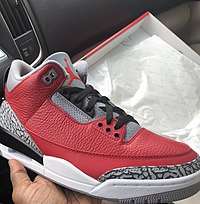
The Air Jordan III was designed in 1988 by Tinker Hatfield, who works for Nike as a designer for stores and offices. By that time Michael Jordan was ready to leave Nike, but the Jordan III changed his mind. It was the first Air Jordan to feature a visible air unit on the heel, the new Jumpman logo, an elephant print trim and tumbled leather to give it a luxury look. The Air Jordan III was also famous for the humorous ads depicting film director Spike Lee as Mars Blackmon, the character he played in his film She's Gotta Have It. This campaign was known as "Mars and Mike", which was one of Nike's most successful advertisement campaigns. These were the first Jordans to feature the "NIKE AIR" logo on the back. These were said to be Michael Jordan's favorite shoes, he wore them during the 1988 NBA Slam Dunk Contest and many other events in his basketball career. The Air Jordan III's had poor sales when first reintroduced in 1994. On their second reintroduction in 2001, they sold well.
In 2007, Jordan Brand collaborated with director Spike Lee to release a limited pair of Air Jordan IIIs with a colorway based on the blue-yellow poster for Lee's film Do the Right Thing.
In 2009, the Jordan Brand reintroduced the highly sought after Air Jordan III in the True Blue colorway. It was an international-only release, meaning they were not sold in the US. In 2011, the brand released a Black History Month (BHM) Air Jordan III colorway in commemoration of the 35th anniversary of Black History Month. Also, the same year saw the release of the "True Blue" III on June 4. The Stealth colorway of the III was released in September and the Black Cements were released in November.[5] The "Black Flips" were released on December 3, 2011. In 2013, Jordan released a special edition of the Jordan III this shoe was deemed the Air Jordan III "Retro '88" White Cement and were released in February.
On February 15th, 2020, the most recent version of the shoe Air Jordan 3 SE “Red Cement” was released in celebration of Chicago, Illinois hosting the 2020 Nba All-Star Game. The brand also debuted a Chicago-exclusive version of the colorway. This pair features “Nike Chi” branding on the heel, replacing the traditional “Nike Air” branding.[6] Multiple retros and new colorways have been released in 1994, 2001, 2007, 2009, 2011, 2013, 2014, and 2016–2020.
Air Jordan IV
.jpg)
In 1989, Nike released the Air Jordan IV to the public. Designed by Tinker Hatfield, it was the first Air Jordan released on the global market. It had four colorways: White/Black, Black/Cement Grey, White/Fire Red-Black, and Off White/Military Blue.
Nike featured director and actor Spike Lee in ads for the AJ IV. Lee had featured the shoe in his movie Do The Right Thing.
Michael Jordan wore the Air Jordan IV when he made "The Shot," a series winner in Game 5 of the 1989 NBA First Round between the Chicago Bulls and the Cleveland Cavaliers. In 2012 a Cavalier colorway dubbed the "Cavs" was released to honor "The Shot."
The Air Jordan IV re-released in 1999, 2000, 2004, 2006, 2008, 2010–2013 and 2015–2020, most recently with the re-release of the, "Black Cat" colorway.
AJ V
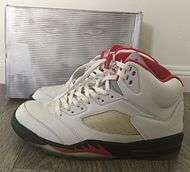
The Air Jordan V was released in February 1990, designed by Tinker Hatfield again. Some elements were carried over from the Air Jordan IV, but overall they were a completely new look. Some of its new features include a reflective tongue (with a unique protruding design and look), translucent rubber soles and lace locks.[7] The soles gave them a new look, but yellowed over time when exposed to moisture and were the source of many complaints early on due to the slippery nature of the soles when collecting dust.
Hatfield is believed to have drawn inspiration for the Air Jordan V from World War II fighter planes, which was most notably visible in the shark teeth shapes on the midsole. The Air Jordan V was reintroduced in 2000, including a new colorway featuring Michael Jordan's high school (Laney High) colors. In 2006 several V's were reintroduced, including the LS "Grape" V's, the LS "Burgundy" V's, the "Fire-Red" V's, the "Green Bean" V's, and "Stealth Blue" V's. Along with the latter, a very limited laser design and the black/metallic/fire red colorways were released in early 2007.
The shoe was retro-ed in 2000, 2006–2009, 2011, and 2013–2017.
The Air Jordan V saw a lot of use in popular sitcom The Fresh Prince of Bel-Air. During many episodes Will Smith wore the 'Metallic Silver', 'Grape', and 'Fire Red' colorway. To pay tribute to his character, Jordan released the Air Jordan 5 Bel Air in 2013.[8]
AJ VI
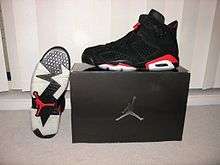
The Air Jordan VI had a new design by Tinker Hatfield and released in 1991. The Original 5 colorways were: Black/Infrared, White/Infrared, White/Carmine-Black, White/Sport Blue, and Off White/Maroon. The Air Jordan VI introduced a reinforcement around the toe, It had two holes in the tongue, and a molded heel tab on the back of the sneaker (demanded by Jordan so it wouldn't hit his Achilles tendon). Like the Air Jordan V, this sneaker also had translucent rubber soles. The Air Jordan VI was the last Air Jordan to feature the Nike Air logo on it.
Later that year the Bulls defeated the Lakers in the 1991 NBA Finals, with Jordan (wearing the Black/Infrared) named as the most valuable player. That was also the first NBA Championship won by Jordan and the Bulls. The Jordan VI was also seen in the film White Men Can't Jump, which was produced in 1991 and released one year later.
The Air Jordan VI has been retro-ed many times since its original release in 1991, Notable releases were in 2000, 2010, 2014 and 2019 with the Black Infrared Colorway.
In addition to a Porsche-inspired rear pull tab and visible air the Air Jordan VI was the first Jordan with an inner bootie.
The shoe was retro-ed in 2000, 2002, 2006, 2008–2010, 2012, and 2014–2017 and 2019.
The VI was the first shoe used by the protagonist of Slam Dunk, Hanamichi Sakuragi.[9] Nike released special versions of both the VI and the Jordan Super.Fly 3 featuring artwork from the series in 2014. The VI also had Sakuragi's number 10 embroidered on the side of the heels.[10] Various other models in the Air Jordan line are featured in the series, including the original (which Sakuragi eventually switched to), the V, and the XII (both worn by Sakuragi's rival, Kaede Rukawa).[11]
AJ VII
The Air Jordan VII was released in 1992 with a new design by Tinker Hatfield. This shoe introduced the huarache technology which allowed the shoes to better conform to the user's foot. A few things were no longer featured on the new model, such as the visible air sole, the Nike Air logo, and the translucent soles. This was the first Air Jordan in the line that did not have any distinctive "Nike Air" on the outer portions of the shoe. The "Nike Air" branding was still on the in-soles, which Air Jordans VIII–XI also had. The VIIs were also known for a successful ad campaign in which Bugs Bunny appeared alongside Michael Jordan to market the shoes.
When Jordan went to compete at the 1992 Barcelona Olympics to play for the US Men's Basketball Team (also known as the "Dream Team"), Nike released a special Olympic color combo of the Air Jordan VII model which had Jordan's Olympic jersey number 9, instead of the usual "23" found on other colorways.
Various models of the Air Jordan VII were re-released in 2002, again in 2004, and again with different colors in 2006.
In 2011 the Air Jordan VII saw releases in the "Orion" and "Bordeaux" colorways. The "Olympic" and "Charcoal" (commonly referred to as Raptors) were re-released in 2012.
The shoe was retro-ed in 2002, 2004, 2006, 2008–2012, and 2015–2017.
AJ VIII
.jpg)
The Air Jordan VIII was released to coincide with the 1992–1993 NBA season. The eighth model of the Air Jordan was noticeably heavier than its predecessors. The Air Jordan VIII model became known as the "Punisher" because of the advanced basketball ankle support and enhanced traction. This shoe contains a full length air sole, polyurethane midsole, polycarbonate shank plate, and two crossover straps (for added support and more custom fit).
The shoe was retro-ed in 2003, 2007, 2008, 2013, and 2015–2017.
AJ IX
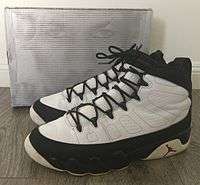
Originally released in November 1993, the Air Jordan IX model was the first model released after Michael Jordan's retirement. Jordan never played an NBA season wearing these shoes. This model was inspired by baseball cleats that Jordan wore when playing minor-league baseball.
Like the VII and VIII models, the Air Jordan IX featured an inner sock sleeve and nubuck accents. The sole featured different symbols and languages of different countries. The Air Jordan IX has been the shoe chosen to adorn Jordan's feet for his statue outside of the United Center in Chicago.
In popular culture, the children's movie The Little Rascals depicted one of the bullies, Butch, wearing a pair of these shoes. American rap icon Tupac Shakur also wore Air Jordans in a popular "Thug Life" photo in 1993.
The shoe was retro-ed in 2002, 2008, 2010, 2012, and 2014–2018.
AJ X
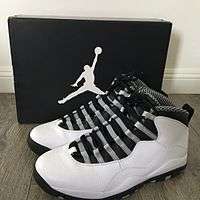
This was released in 1994 in three colorways - White/Black/Light Steel Grey 'Steel Grey,' White/Black/Dark Powder Blue 'Powder Blue,' Black/Dark Shadow/True Red 'Shadow.' More followed: Powder Blue (worn by University of North Carolina at Chapel Hill's Men's and Women's basketball teams), Orlando Magic*, New York Knicks*, Seattle SuperSonics*, and Sacramento Kings*. It was the first Air Jordan to feature a lightweight Phylon midsole. The shoe also featured all of Michael Jordan's accomplishments up to his first retirement on the outsole.
In 2012, the Air Jordan X was re-released. They are dubbed the "Chicago Bulls", as they are part of a regional pack (City Pack), representing five teams. The lacing and tongue are completely black, and the red inner lining contrasts with the red inserts on the outsole. The outsole's design features a striped (wavy) design, which list many of Jordan's accomplishments. They retailed at $160. The Air Jordan X was released again in an OVO collaboration in 2015 and 2016, releasing in white and black colorways respectively with stingray detailing.
The shoe was retro-ed in 2005, 2008, 2012–2016, and 2018.
AJ XI

This model was designed by Tinker Hatfield. When the shoe launched, Michael Jordan (retired from basketball by then) was with the Birmingham Barons in baseball's minor baseball leagues. Hatfield designed the sneaker waiting for Jordan to come back and hoping he would play in them.
The ballistic mesh upper of the sneaker was meant to make the Air Jordan XI lighter and more durable than past sneakers. Further changes came with the use of a carbon fiber spring plate in the translucent "frosty" outsole, giving the shoe better torque when twisting on the court. The highlight and arguably best-known aspect of the shoe is its patent leather mudguard. Patent leather was lightweight compared to genuine leather and also tended not to stretch as much – a property to help keep the foot within the bounds of the foot bed during directional changes on the court. The patent leather gave the XI a "formal" look. When this shoe released, some wore this model with business suits instead of dress shoes.
The sneakers were only samples in 1995 when Jordan decided to come back to the NBA. Hatfield and Nike discouraged Jordan from playing in them, but once they were produced, he couldn't resist. Also noteworthy, Jordan violated league dress code by wearing the shoes, as his teammates wore all-black shoes. It wasn't the first time Jordan had run afoul of NBA footwear rules, having broken them with his very first signature shoe in 1985. He was fined $5,000 for not following the Bulls' colorway policy with the AJ XI. After the fine, Nike made him a pair of the shoes in a black/white/concord colorway for the series against Orlando. A similar black/white/royal blue colorway was released to the public at the end of 2000. The colorway was changed for the public release because the concord purple had looked like royal blue on television.
Jordan wore the Air Jordan XI on the way to helping the Chicago Bulls claim the 1995–96 NBA Championship. He also wore the XI white Columbia colorway in the 1996 NBA All-Star Game and was selected MVP of the game. The shoes received more media exposure when Jordan wore the Air Jordan XI model in the 1996 animated movie Space Jam. These shoes were eventually released in 2000 and re-released in 2009 with the nickname "Space Jams." The concord purple was changed to royal blue for the released versions of the shoe.
The Air Jordan XI was originally released from 1995 to 1996. It was retro'd in 2000, 2001, 2003, 2006–2018 and 2019. The Air Jordan XI is the most popular Air Jordan in the series and has released almost ritualistically every December since 2008, selling out in minutes. It also is Hatfield's favorite. With the Air Jordan XI being the most popular Jordan, supply used to be very limited and would cause fans to line up outside of stores before releases.
AJ XII
Main article: Air Jordan Retro XII
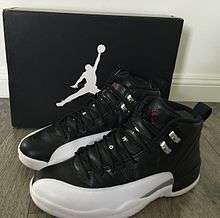
The Air Jordan XII was inspired by Nisshoki (the Japanese flag), and a 19th-century women dress boot. However, featuring gold-plated steel lace loops, embossed lizard skin pattern and a full length zoom air unit with a carbon fiber shank plate, this model set a new direction in style and technology in shoe design. Though not as light weight as previous models, the construction and firmness of the shoe is widely considered to be the most durable and sturdy shoes from the Air Jordan line. The first model released after the creation of subsidiary Jordan Brand, the Air Jordan XII has no Nike branding on it of any kind, while all the models before it have Nike Air or other Nike branding outwardly (Air Jordans I-VI) or just simply on the insoles (Air Jordans VII–XI). This shoe came in 5 colorways and was released on March 13. The shoe was re-released on December 25, 2008 with the Eleven as the final countdown pack. In addition, the Twelve was combined with the Thirteen numbered Jordan to produce the 12.5. As of today, the 11/12 countdown package (retro) retails for US$750–US$800, well above the starting price of US$310. The Air Jordan XII has been subject to many highly limited colorways recently such as the Air Jordan 12 x PSNY collaboration, the Wings colorway that was limited to 12,000 pairs, and the OVO collaboration.
The Air Jordan XII was originally released from 1996 to 1997. It was retro-ed in 2003, 2004, 2008, 2009, 2011–2013, and 2015–2018.[12]
AJ XIII
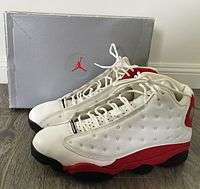
In 1997, Air Jordan XIIIs were released to the public. This model was known for its cushioning along the feet, designed by Hatfield. The Black Panther was the inspiration for the Air Jordan XIII, the sole resembles the pads on a panther's paw. But also the panther is the hologram on the back of the shoe which imitates a panther's eyes in the dark when light is shined at them. They were re-released in 2005, which coincided with the release of the Air Jordan 8s shoe.
In the movie He Got Game, the Air Jordan XIII was worn by Jake Shuttlesworth (Denzel Washington). Ray Allen, who played Jake's son Jesus in the film, wore them when he broke Reggie Miller's all-time record for made three-point shots during a game against the Lakers in Boston during the 2011 season. The Jordan Brand re-released the Air Jordan XIII at the end of 2010, which included the French Blue/Flint Grey, White/Red-Black, "Playoff" color way and the Black/Altitude Green color way. In 2017, Jordan Brand released the "History of Flight" colorway. This colorway is from the 2009 World Basketball Festival, where the "History of Flight" collection was revealed to celebrate Jordan's 25th anniversary.
The shoe was retro-ed in 2004, 2005, 2008, and 2010–2018.
AJ XIV
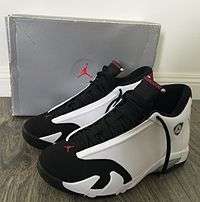
Inspired by the Ferrari 550 M which Michael Jordan owned, the Air Jordan XIV was originally released from 1997 to 1999. It was re-released in 2005, 2006, 2008, 2011, 2012 and 2014–2018.
The Air Jordan XIV co-styled by Hatfield and Mark Smith was made race ready and equipped with the Jordan Jumpman insignia on a Ferrari shaped badge. In addition, these shoes include breathable air ducts on the outer sole. The color scheme of predominant black accentuated with red was nicknamed "The Last Shot" because Michael Jordan wore them as he hit the game winning shot over Bryon Russell, of the Utah Jazz, in his final game with the Chicago Bulls in the 1998 NBA Finals.
There are 14 Jumpman logos on Air Jordan XIV's—7 on each shoe—corresponding the shoes' number in the series. They can be found in the following places:
- Near the toebox × 1
- Shield Logo near the achilles heel × 1
- Above the number "23" at the heel × 1
- At the bottom sole (middle part) × 1
- Steel Lacetips × 2
- Insoles × 1
AJ XV
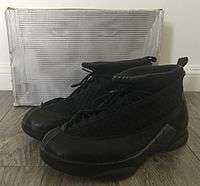
The Air Jordan XVs were released in 1999–2000. Reggie Miller wore it during the 2000 NBA Finals.
This was the first shoe after Jordan's retirement. The design of the XV's originated from the aircraft prototype X-15, which was developed by NASA during the 1950s. The sides of the XV were made from woven kevlar fibre. The Jordan XVs were the first Air Jordans to be negatively received in a while (the last being the Air Jordan 2s), because the quality on the Jordan shoes was bad.[13]
The shoe was retro-ed in 2007, 2008, and 2016–2017.
AJ XVI
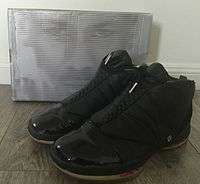
Air Jordan XVIs, designed by Nike's Senior Footwear Designer Wilson Smith, were released in 2001. This meaning it was the first design since the II's that Hatfield was not behind. Smith decided to bring in a few design elements/fabrics from earlier releases. The shoe featured the return of the clear rubber sole (V, VI, XI) and patent leather (XI).
Unique to the Air Jordan XVI was a gaiter/shroud that covered the shoe and could be removed to give the shoe a new look. Not only was this for fashion purposes, it also had a thermal functionality.
The shoe was said to be stiff and that the shroud/gaiter could easily fall off when playing basketball. The black/red and white/midnight navy versions of the shoe both featured patent leather which very easily creased and cracked.[14]
The shoe was retro-ed in 2008, 2014, and 2016.
AJ XVII
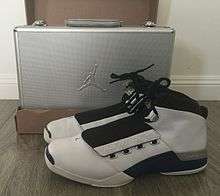
This pair of Jordans come equipped with Keefer, which held the shoes and a compact disc containing the Air Jordan XVII song. The retail price of the shoe was US$200. The defining functional design element of the Air Jordan XVII model, which was later replicated on the Air Jordan XXIII model, was the reinforced mid-sole which provided a sturdy and stable chassis for the shoe. They were made in four mid top colors and three low-top colors.
Some of the original colorways are:
- Original Black / Metallic Silver
- Original White / College Blue – Black
- Original White / Varsity Red – Charcoal
- Original white / Black Metallic Copper – Sport Royal
The shoe was retro-ed in 2008 and 2016.
One of the retro-ed colorways is:
- Retro Black / Metallic Siver Countdown pack.
AJ XVIII
.jpg)
The Air Jordan XVIII shoe was released in 2003, and was the shoe for Jordan's last season, in which he played for the Washington Wizards.
The shoe was designed by Air Jordan Senior Footwear Designer, Tate Kuerbis, a person that had been part of the Jordan footwear design team since 1999 and with Nike since 1995. The inspiration for the design came from a number of things; sleek racing lines of the auto world, carbon fibre-based monocoque of F1 race cars, race car driving shoes (rubber heel wrap) and Fine Italian dress shoes (bold stitching on the soles).
The shoe was retro-ed in 2008.
AJ XIX
.jpg)
Released in 2004, this is the first Jordan release after his third, and final, retirement which came after the 2002–03 NBA season. The design was inspired by the black mamba snake, and two original colorways where released: white/flint grey and black/red. Three regional colorways and three special edition colorways were released. They consisted of the East, West, and Midwest edition for regular and West, East, and Olympic for the SE (special edition).
The Air Jordan XIX used innovative materials. The upper section of shoe was developed in collaboration with the global materials consultancy Material ConneXion, who sourced Nike a sleeving normally used in architectural applications for protecting PVC pipes from bursting. In theory, this allowed for a shoe without laces, because the sleeving does not stretch. Nonetheless, the Air Jordan XIX model did include a set of laces behind the sleeve to better secure the shoe. They are the lightest Air Jordans ever made.
The shoes appeared on the sitcom My Wife And Kids, in the episode "Fantasy Camp: Part 2", when the protagonist Michael Kyle (Damon Wayans) steals it from Jordan's hotel room and uses it to play against Jordan himself later in the episode. Michael Jordan wears "AJ IV Cool Grey" in the episode.
The shoe was retro-ed in 2008.
AJ XX
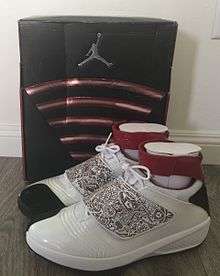
The Air Jordan XX was also inspired by bicycling shoes. The strap was placed in the center of the shoe over the laces. It also helped to create a tighter fit and increased support.
The shoe was retro-ed in 2008 and 2015.
AJ XXI
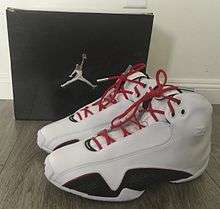
The Air Jordan XXI model of shoes was designed by D'Wayne Edwards and inspired by sport touring vehicles. The shoe features lower-foot air grilles, double-overlasted Phylon midsole, a carbon fibre shank plate and a seamless diamond-quilted booty. It also has a tenable I.P.S. suspension system that lets the wearer choose between Zoom and Encapsulated air.
The Air Jordan XXI was introduced on television by the "Second Generation" advertisement.
The Air Jordan XXI was originally released in 2006. It was retro-ed in 2008.
AJ XX2
.jpg)
The Air Jordan XX2/XXII shoe model, designed by D'Wayne Edwards, was released on March 24, 2007. The original retail price of the model was US$175. The aggressive and sharp design was inspired by the F-22 Raptor fighter jet. Some technical features of the shoe include an updated visible and interchangeable I.P.S. suspension system, a new metallic mesh for ventilation, the Air Jordan camouflage pattern printed in reflective 3M material, and an updated traction system, based on an army general's stripes.
Two special editions of the Air Jordan XX2 model were released. The first edition was released for Jordan's birthday on February 17. This edition featured authentic Jordan Brand basketball leather. The second edition was the Omega model, part of the Alpha-Omega package. This model featured a laser-etched image of Jordan after he won his sixth NBA championship in 1998.
An entirely new line of Air Jordan XX2/XXII shoes called the released, with these shoes worn by NBA players from the Atlanta Hawks, Denver Nuggets, Detroit Pistons, and Dallas Mavericks. This Air Jordan model featured a new strap around the heel and ankle.
The promo commercial for the XX2 was directed by Mark Romanek.[15]
The shoe was retro-ed in 2008.
AJ XX3
.jpg)
The Air Jordan XX3 was designed by Tinker Hatfield. It was a unique model, being the first basketball shoe to be included in the "Nike Considered" category, for using materials from not more than 200 miles from a Nike Factory. It features a hand-stitched exterior, full-length bootie, carbon fiber shank plate, the last to feature interchangeable IPS pillars, and an articulated chassis. The shoe was released on January 25, 2008, and was the last Air Jordan until the XX8 to have Roman numeral identification.
The shoe was retro-ed in 2015–2016.
AJ 2009
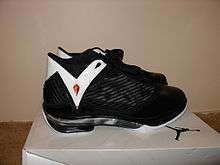
The Air Jordan 2009 was designed by Jason Mayden and was the first Air Jordan model named after the year of its release rather than its numbered system. Inspired by Jordan's defensive focus, the shoe incorporates Articulated Propulsion Technology used by Paralympian runners. It also features a durable pleated silk upper, protective TPU chassis, carbon fiber arch plate and Zoom Air structure. The shoe was released on January 31, 2009.
The shoe has not been retro-ed.
AJ 2010
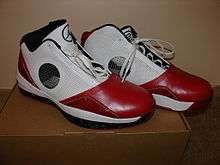
This is the 25th anniversary of the Air Jordan brand, and although commonly called the Jordan 2010s, is also referred to as Air Jordan XX5/XXV. This model of shoe was announced on November 12, 2009, for a release date of February 13, 2010, retailing for US$170. Dwyane Wade is endorsing the AJ 2010.
The base of the each mid-sole has stylized text that when combined reads: "I've failed over and over and over again in my life. And that is why I succeed." This quote was originally attributed to Michael Jordan, and is a reference to an advertising campaign that aired in 1997 with Jordan detailing his failures that led to his success in his career.
The shoe has not been retro-ed.
AJ 2011
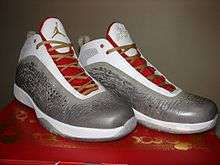
The Air Jordan 2011 was endorsed by Dwyane Wade in 2011, Jordan Brand decided to keep the fans happy with the release of the Air Jordan 2011. The shoe has inter-changeable insoles – The Red, "Explosive" one is claimed to symbolize power, and a Blue, "Quick" one, supposedly for quickness. Four colorways of the shoe were released on February 19, 2011 in correspondence with the 2011 All Star Game. The first colorway was White/Black. There were also White/Red and White/Blue colorways that coincided with the East/West Jersey Colors. The "Year of the Rabbit" colorway was a limited release that celebrated of Michael Jordan's Chinese zodiac sign, coinciding with the current zodiac sign, the Year of the Rabbit.
The 2011 has a unique design along both sides of the shoe. It is a star-constellation pattern that also serves as breathing holes for the shoe to keep it well ventilated. It uses patent leather wrapped around the shoe. The shoes are hand burnished and crafted. A dress shoe that feels similar to the XI was reported to be the goal.
The shoe has not been retro-ed.
AJ 2012
Air Jordan 2012 offers six customization configurations. Two interchangeable sleeves and three insoles adapt to different playing styles. The Deluxe model was launched on February 8, while the customization Flight models were released on February 25, 2012. It was the final Air Jordan model to be named after the year it was released as the numbered system returned in 2013 with the Air Jordan XX8.
The Air Jordan 2012 was originally released in 2012. It has not been retro-ed.
AJ XX8
The Air Jordan XX8, designed by Tinker Hatfield, was released on February 16, 2013. This premiere model featuring a mostly black upper and volt Dynamic Fit bootie. A heel and forefoot Nike Zoom unit in combination with the new Jordan Flight Plate, Dynamic Fit straps for increased support, a carbon fiber heel counter for additional support, and its most notable feature, the mesh upper for flexibility and ventilation. Jordan Brand has decided for 2013 to returning to the Air Jordan numbered order after having stopped at XX3. The Air Jordan 2012 featured different technology which including interchangeable insoles for various styles of play, a concept introduced with the Kobe System. The exterior shroud gives the shoe a sleeker look than any other and is 8 inches high on the ankle but unzips and folds down revealing the bright volt green interior.
AJ XX9
The Air Jordan XX9, also designed by Hatfield, released in September 2014 in both an elephant print and a knit edition. The shoe has already been debuted in the NBA by Russell Westbrook and Kawhi Leonard. The shoe has Flight Web for superior lockdown, a performance woven upper for comfort, support, strength, and protection, and a re-engineered Flight Plate. The XX9 also released in a pack alongside the iconic Air Jordan XI on December 23, 2014 called the "Ultimate Gift of Flight" pack.[16]
Jordan released two versions of this shoes. The regular cut and the low version. Some of the colorways released in low version are buckets, Chicago bulls, UNC, and infrared.
AJ XXX
The Air Jordan XXX (30) debuted on January 14, 2016 at an exclusive media event in Chicago. It was again designed by Tinker Hatfield. The first colorway of the shoe released on February 16.[17] The shoe consists of an upper and outsole very similar to that of the XX9 of the previous year. The upper is a combination of performance woven and flyknit that is new for the brand in 2016, and also has a flyknit-constructed ankle collar that extends slightly past where the collar of the shoe would normally be. Jordan brand has also brought back functional Dynamic Fit in the lacing system. The outsole/midsole is almost identical to the XX9, with very minor technical tweaks. The outsole boasts a more noticeable change, with a different traction pattern unique to this shoe, while the midsole remains almost entirely the same. The only difference in the midlsole cushioning setup from the Jordan XX9 is a material change in the FlightPlate setup, which is now named FlightSpeed and is constructed of a plastic rather than carbon fiber for more flexibility while remaining structural integrity.
AJ XXXI
The Air Jordan XXXI (31) was unveiled on July 20, 2016. The sneaker is heavily influenced by the Air Jordan 1's having a leather upper and both a Nike swoosh and a Jumpman plus a Jordan "Wings" logo.[18] Its first retail debut was on September 3, 2016 in the "banned" colorway for $185 alongside its air Jordan 1 counterpart.[18] Notable appearances of the AJ 31 include the "USA" colorway worn during the 2016 Olympic basketball tournament by members of team USA.[19]Basketball at the 2016 Summer Olympics – Men's team rosters.
Some of the colorways released are Camo, QUAI 54, Black/Gold, Chicago Away, Chicago Home, Black/White, Midnight Navy, Jordan Brand Classic, and WHY NOT that celebrates Russell Westbrook's fashion sense.
AJ XXXII
The Air Jordan XXXII (32) was first released on September 23, 2017. This model is heavily influenced by the Air Jordan 2. It also included a Jordan "Wings" logo. It first came out in the "Rossa Corsa" colorway. A special "Banned" colorway was released on October 18, 2017 to coincide with the 31st anniversary for when the NBA banned the original AJ I black and red colorway. Another special edition called the "Russ" colorway was released to celebrate Russell Westbrook's sponsorship with the Jordan brand. Jordan brand released 2 types of this shoe, the original mid length cut and low cut. Some of the colorways they released for low version are freethrow line, camo, like mike, wheat, wing it, and last shot. Money
AJ XXXIII
The Air Jordan XXXIII (33) was released on October 18, 2018. This is the first Air Jordan model to go laceless.[20]
Other shoes from the Air Jordan line
The Jordan Packages
"Spizike"
Michael Jordan and Spike Lee released the Jordan Spiz'ike shoes on October 21, 2006, as a tribute to their historic relationship.[21] The relationship began when Mars Blackmon (a character from Spike Lee's film, She's Gotta Have It) became the primary pitchman in Nike commercials for Air Jordans. The Spiz'ike is a mash-up of the Jordan III, IV, V, VI, Air Jordan IX and XX shoes. Only 4,567 pairs were made of the original release,[21] with all of the proceeds going to Morehouse College. Each future release of the shoes varied the colors used.
"Defining Moments"
Released in 2006 retailing at $295 containing the sneakers Michael Jordan wore during his first championship of his two three-peats. The retro 11 concord contains a gold Jumpman on the side, but originally was meant to also have gold eyelets spelling out Jordan was changed because of color bleeding. The retro 6 black infrared replaces its infrared for gold as well. Both shoes contained dog tags to reference the title won and a booklet showcasing a slam dunk highlight of the game and concept art of the shoe. Some of the original DMP retro 11 concords have surfaced and are considered some of the rarest air Jordans.[22]
"Defining Moments II"
The "raging bull pack" retailed for $310 and drew inspiration from the running of the bull that takes place every year in Spain. The pack contains two Air Jordan 5s; the Toro Bravo and the 3m. The Toro Bravo is a red suede sneaker, one of the first of its kind, and it takes inspiration from the red bandanas worn by the runners. The second pair, the 3m, is named after its reflective coating. Both shoes come in a wood gate exterior graphic box with double sided slide out, originally released in 2009.[23]
"Defining Moments III"
The Jordan Brand released a third "Defining Moments" package on July 11, 2009. The 60+ Air Jordan Retro 1 Package is inspired by Jordan scoring 63 points on the Celtics in a double overtime playoff game during his second year. The Air Jordan Retro 1 60+ Package features a re-release of the sneakers that Jordan wore during that game, and a Retro Air Jordan 1 inspired by the Celtics colors and the parquet floors from the old Boston Garden.
"Defining Moments IV"
Retro 6 Infrared Pack
The Jordan 6 white/infrared and black/infrared was released February 14, 2013, at a retail price of US$170. This is the second of the same colorway retro in Jordan Brand history. The first time retro on both colorways were in 2000, they were retro separately. This time, the retro distinguished with the previous release. The heel logo are using Jumpman logo instead of Nike Air logo, this is the most significant difference between these two re-releases. Jordan Brand started using Jumpman logo
"Old Love New Love"
The Jordan Brand released their second two-pair package named the "Old Love New Love" (OLNL), which consisted of the Air Jordan I Retro model in Mid White/Black-Varsity Red (Black Toes) and Black/Varsity-Maize/White. It was released on April 21, 2007. The Old Love New Love package was sold for $200.00. The pack represented Jordan's passions, the old love being basketball the new love being motorcycle racing.[24]
Air Jordan Brand released 5 new colorways including one that is themed after another Spike Lee's "Do The Right Thing."
There will be more colors of the Air Jordan Spizikes released than of the recent Air Jordan 3 retro re-release. The Air Jordan "Spiz'ikes" take pieces from the following Air Jordans:
- Air Jordan 3 – sole, midsole, and "Spike"/elephant print
- Air Jordan 4 – "wings" on the sides of the shoes that hold lace loops to place.
"Air Jordan Sixty Plus"
The first Jordan Sixty Plus was released in August 2009. The Jordan 6ixty Plus (60+) is a hybrid sneaker from Jordan Brand that combines the various sneakers Michael Jordan wore when he scored 60 or more points in an NBA Game. In these games, MJ was wearing the Jordan I, II, V and VII. Inspiration came from the Air Jordan 5 because he was wearing those when he scored his career high of 69 points.
- Air Jordan 1 – Toebox shape and perforations
- Air Jordan 2 – Snakeskin accents, rear TPU, lower Eyelets, Jordan "Wings" logo on tongue
- Air Jordan 5 – Midsole/Outsole, shape of tongue, Lacelock, mold of upper near ankle, higher eyelets, "Air Jordan" tag inside of tongue
- Air Jordan 7 – Perforations on side panel, "gap" between ankle area and body of shoe, graphics on tongue, heel tab, 23 on rear TPU
"Jordan Son of Mars edition"
The "Jordan Son of Mars" is an Air Jordan hybrid shoe, that released in the Summer of 2012. It borrows prominent design elements from the Air Jordan III, IV, V, VI, and XX. It also retains a strap across the shoe laces, that is a custom modification with a design that seems to be elephant print but is instead a series of relevant icons, etc. The Jordan Son of Mars was birthed from the Spizike, which was originally inspired by all the Jordan shoes made in collaboration with famous urban director Spike Lee. Son of Mars is a sneaker directly influenced by Spike Lee's longtime involvement with the brand, as the shoe pieces together models in which Spike (or Mars Blackmon rather) had a hand in launching.
The shoe breakdown begins with elements from the first Tinker Hatfield years, Mars Blackmon; Lee's loudmouthed character first appeared alongside Michael Jordan for the release of the Air Jordan III, a sneaker whose immediately recognizable elephant print bookends the Jordan Son of Mars, with sectioning on the back end and towards the toe. Next the Air Jordan IV, which is pretty conspicuous in this hybrid release, shows up only in the form of the netting running below the laces. The sole construction is all Air Jordan V, as the coveted icy treatment splashes across the bottom and the angular 'teeth' of the midsole rear up towards the toe. The V actually extends its reach to the top end too, with the textured Jumpman tongue bursting out from the familiar see-through lacelocks. Building up the ankle area is the higher-hitting support of the Air Jordan VI, complete with the attached loop on back and the perforated paneling reaching up the side of the shoe. The midsection which completes the sneaker is a major fast-forward, leaping ahead to the Air Jordan XX in the form of the lasered strap.
The Jordan Son of Mars takes on one of the favorite color schemes in the Jordan Brand line.
"Air Jordan Collezione/Countdown packages"
This package consisted of two variations of Retro Air Jordan, in which each model number equaled 23. So the Retro I was released in a package with the Retro XXII, the Retro II with the Retro XXI, etc.
"Air Jordan X/XIII "
The first Countdown package consisted of the reintroduced Air Jordan XIII model in white/black-true red. The package also included a pair of the shadow grey Air Jordan X model with the number 23 stitched on the side of the shoes. The package cost
"Air Jordan IX/XIV"
The second Countdown package consisted of the Air Jordan Retro XIV model in Black/Varsity Red which was similar to the Air Jordan "Last Shot" XIV model though it consisted of a white stitching on the sides, a different color outer arch, and a different colored Jumpman logo on the side. The other Air Jordan was the Air Jordan Retro IX model in a White/Black/True Red colorway. The package retailed for US$310.00 and was released March 15, 2008.
"Air Jordan XXI/II"
The third Countdown package consisted of the Air Jordan Retro II model in White/Varsity Red. The other Air Jordan in this package was the Air Jordan Retro XXI model in Black/Varsity Red. The package retailed US$310.00 and was released April 26, 2009.
"Air Jordan XVII/VI"
The fourth Countdown package consisted of the Air Jordan Retro VI model in White/Carmine. The other Air Jordan in this package would be Air Jordan Retro XVII model in Black/Metallic Silver. The package cost US$310.00and was released May 24, 2008.
"Air Jordan XII/XI"
The final Countdown package consisted of the Air Jordan Retro XI model in Varsity Red/Black. The other Air Jordan in this package was the Air Jordan Retro XII model in Black/White.
Jordan Fusions
This line of sneakers consist of a fusion of several Air Jordan and Air Force One Models.
Air Jordan XII Air Force One Fusion
A fusion between the Air Jordan XII model and the Midtop Air Force One model.
Air Jordan III Air Force One Fusion
A fusion between the Air Jordan III model and the Air Force One model.
Air Jordan V Air Force One Fusion
This package is the only original colorway of the Air Jordan V model that was not released in the last round of re-releases. Like the Air Jordan V model, the outsole is a mix of black and clear rubber; there is no visible air sole unit in these shoes. The shoe a rubber loop in the back, middle upright cotton jumpman, rubber tongue, and the lace lock first was brought in an infrared colorway. It is said Michael Jordan wears these shoes in his practice games.
Air Jordan VI Air Force One
A fusion between the Air Jordan VI and the Air Force One model.
Air Jordan XX Air Force One Fusion
A fusion between the Air Jordan XX and the Air Force One model. These feature the same laser upper as the original XX but replace the ankle strap and sole with that of the Air Force One. Has the numbers one through till six on the heel to represent Jordan's 6 championships ever.
Air Jordan IV Air Force One Fusion
A fusion bet
Air Jordan VIII Air Force One Fusion
A fusion between the Air Jordan VIII and the Midtop Air Force One model.
Air Jordan IX Air Force One Fusion
A fusion between the Air Jordan IX and the Air Force One model.
Air Jordan X Air Force One Fusion
A fusion between the Air Jordan X and the Midtop Air Force One model.
Air Jordan XIII Air Force One Fusion
A fusion between the Air Jordan XIII and the Midtop Air Force One model.
Jordan "6 Rings" shoe

The Jordan 6 Rings (aka Jordan Six Rings) is a combination of the seven Air Jordan shoes that Michael Jordan wore during his 6 Championship seasons. That includes the Air Jordan 6, 7, 8, 11, 12, 13 and 14. The Jordan Brand company released the "6 Rings" shoes starting in September 2008.
The Jordan Brand released colorways representative of each team that the Chicago Bulls defeated in each of their six championship seasons during the 1990s. The colorways include colors borrowed from the following teams: the L.A. Lakers, Portland Trail Blazers, Phoenix Suns, the former Seattle SuperSonics, and Utah Jazz, each shoe of which includes laser-etched graphics detailing specific aspects about that particular championship series, the city of the competing team and so forth. Many other colorways exist and Jordan Brand continues to release additional colors that pay tribute to different Jordan and Nike shoes along with new colorways specific to 6 Rings shoes.
There even exists a "winterized 6 rings" which are a modified 6 Rings shoe turned into a durable boot designed for the outdoors which changes some of the design and placement of the inspired pieces and parts from the Air Jordans the shoe pays tribute.
Of particular note, there is an Olympic colorway, a Nelly version apparently inspired by the rap artist Nelly and a shoe that combines the colors of all the teams that the Bulls defeated in the NBA Finals, acting as the 'sixth shoe' since only five separate teams were defeated for the Bulls to win six championships; the Utah Jazz was defeated twice, in 1997 and 1998.
- Air Jordan 6: Heel tab "spoiler", Jumpman on heel from retro 6 models, and lace locks
- Air Jordan 7: Nike Huarache style inner sock and perforated air holes in the mudguard of the upper
- Air Jordan 8: Chenille carpet-style sections on the tongue surrounding the Jumpman logo, dual velcro straps, the shape of the "23" printed on the lace locks and the colors on the midfoot arch plate on the sole
- Air Jordan 11: Silhouette of upper, lace eye-stays on certain models and patent leather mudguard
- Air Jordan 12: TWO 3 embroidered on the tongue and metal lace loops at top of the ankle
- Air Jordan 13: Midsole "pods" and panther paw-shaped outsole
- Air Jordan 14: Small Jumpman logo embroidered at the top
- Air Jordan 15: insole
Controversy
The Air Jordan line has been associated with many riots, assaults, robberies, and murders,[25][26][26][27][28][29][30] such as the murder of a 15-year-old high school student named Michael Eugene Thomas who was choked to death by one of his peers for a pair of Air Jordan sneakers in 1989.[31]
In 1988, principal Dr. Robin Oden of Mumford High School in Detroit mentioned that clothing-related violence had reached a point where he felt it was necessary to ban certain items of clothing, including the Air Jordan sneaker, from the school grounds.[32] This ban was the first of many dress codes implemented in schools after the wave of robberies, beatings, and shootings over possession of Air Jordan sneakers and other items of clothing.[33]
Manufacturing
Nike owns none of the factories where Air Jordans are produced and contracts the work to various factory owners. Company officials say that they only design and market the shoes. However, Nike dictates production terms and standards to the contractor, often without questioning labor or safety practices. In April 1997, 10,000 Indonesian workers went on strike over wage violations at an Air Jordan factory. The same month in Vietnam 1,300 workers went on strike demanding a 1-cent-per-hour raise, and a year later in 1998, 3,000 workers in China went on strike to protest hazardous working conditions and low wages cause.[34]
Sponsorship
Starting in 2016, Air Jordan became the sole equipment provider for the University of Michigan American football team.[35]
This marked the brand's first venture into a sport besides basketball. As of 2018, Air Jordan was also the equipment provider for the University of North Carolina, University of Oklahoma, and University of Florida football programs.[36]
In 2018, the Jordan brand sponsored an association football (soccer) team for the first time in its history, when French club Paris St Germain displayed the jumpman logo on their third kits, worn in the 2018–19 edition of UEFA Champions League.[37]
American football
Teams
Players
- Davante Adams
- Jamal Adams
- Earl Thomas
- Joe Haden
- Jordan Reed
- Melvin Ingram
- Thomas Davis
- Alshon Jeffery
- Malik Hooker
- DeShone Kizer
- Dwayne Haskins
- Le'Veon Bell
- Jimmy Garoppolo
- Sterling Shepard
- Jordan Howard
- Cameron Jordan
- Dont'a Hightower
- Bobby Wagner
- Tyrann Mathieu
- Michael Thomas
- Dez Bryant
- Michael Crabtree
Association football
Baseball
Basketball
College Basketball
Club teams
High school teams
.svg.png)



Players
NBA players
- LaMarcus Aldridge[41]
- Carmelo Anthony[42]
- Dwayne Bacon[43]
- Bismack Biyombo[44]
- Mike Conley Jr.[45]
- Luka Dončić[46]
- Andre Drummond[47]
- Blake Griffin[48]
- Rui Hachimura[49]
- Michael Kidd-Gilchrist[50]
- Victor Oladipo[51]
- Jabari Parker[52]
- Chris Paul[53]
- Otto Porter Jr.[51]
- Jayson Tatum[54]
- Moe Wagner[55]
- Kemba Walker[56]
- Russell Westbrook[57]
- Zion Williamson[58]
- Cody Zeller[51]
WNBA players
Other players
BMX
NASCAR
Tennis
Jordan WINGS
The Jordan Brand partners with UNCF to fund the higher education of underprivileged youth.[59]
Collaborations
Artist Collaborations
Air Jordan is well known for reaching out to popular music artists and having them help create a unique Air Jordan to call their own. These include artists like Travis Scott, Eminem, Drake, and Joy from Red Velvet.
Designer Collaborations
Air Jordan is popular among the streetwear companies and designers to collaborate with. Jasper Lutwama and Aidan Vryenhoek are known to have signed a 10 million dollar deal which will span over 3 years. Together they create several unique Jordans that greatly impact both companies. Some of the most popular collaborations to date include Virgil Abloh and his brand Off White, and Supreme.
Notes
- The date the "Air Jordans I" was released.[1]
References
- "NIKE, Inc.— Inspiration and Innovation for Every Athlete in the World". Archived from the original on May 20, 2013. Retrieved November 8, 2016.
- "Still The One: Why the Remastered Chicago Jordan 1 Is a Must-Have". Retrieved March 1, 2018.
- DePaula, Nick (July 21, 2016). "The true story of the banned Air Jordans". Yahoo News.
- "The True Story Behind the Banned Air Jordan". Retrieved November 8, 2016.
- "Air Jordan 3 Black Cement Retro".
- Briguglio, Mario (January 23, 2020). "Air Jordan 3 Red Cement CK5692-600 Release Date - Sneaker Bar Detroit".
- "Retro Vibes: Revisiting Air Jordan 5 Greatness • CultEdge.com". CultEdge.com. Retrieved January 31, 2018.
- "Air Jordan 5 Bel Air • KicksOnFire.com". KicksOnFire.com. Retrieved September 22, 2016.
- "Air Jordan Shoes That Used in The Slam Dunk Manga Series !!".
- Marcelo, John (October 16, 2014). "Nike Officially Unveils the Jordan Brand "Slam Dunk" Collection". Complex.
- So, Daniel (October 30, 2014). "The Best Sneakers from the Slam Dunk Manga and Anime Series". Complex.
- "Ray Allen Stats, Bio and Game Logs". NBA.com. July 20, 1975. Retrieved April 23, 2013.
- "Nike Store. Mens Jordan Shoes, Clothing and Gear". Air-jordans.com. Archived from the original on February 12, 2011. Retrieved February 23, 2012.
- "Nike Store. Men's Jordan Shoes, Clothing and Gear". Air-jordans.com. Archived from the original on September 17, 2010. Retrieved February 23, 2012.
- "Jordan Brand Marketing Campaign Comes Through in the Clutch". Oregon: Prnewswire.com. Retrieved October 19, 2011.
- "Air Jordan 29 Basketball Shoe – Tailored for Flight". Nike.com. Retrieved January 12, 2015.
- "Air Jordan 30 Bugs Bunny Teaser | SneakerNews.com". Sneaker News. Retrieved October 28, 2015.
- "Jordan Brand Officially Unveils The Air Jordan 31". Retrieved September 21, 2016.
- JustFreshKicks (July 18, 2016). "Air Jordan XXX1 "USA" 31 Olympic 2016 - JustFreshKicks". Retrieved September 21, 2016.
- DePaula, Nick (October 10, 2018). "Nike's new Air Jordan 33 goes laceless". ESPN. Retrieved October 10, 2018.
- "Jordan Spiz'ike Boot (legendary release 2009)". Retrieved September 11, 2018.
- "In Context: Air Jordan Defining 'Moments Pack'". Retrieved September 24, 2016.
- "Air Jordan V (5) 2009 DMP Retro - Toro Bravo - Raging Bull - SneakerNews.com". Retrieved September 24, 2016.
- "Air Jordan 1 - Beginning Moments / Old Love New Love Pack - 2007 - SneakerNews.com". Retrieved September 27, 2016.
- "Michael Jordan to Blame for Riots Over Shoes: What Isiah Thomas Said and 5 Things He Could Do With Nike Profits". Rollingout.com. Retrieved April 23, 2013.
- Shapiro, Marc (December 10, 2012). "Air Jordans Stolen from Teens in Mall Robbery – Owings Mills-Reisterstown, MD Patch". Owingsmills.patch.com. Archived from the original on April 11, 2013. Retrieved April 23, 2013.
- "Police use pepper spray to end fights over Air Jordans". Latimesblogs.latimes.com. December 23, 2011. Retrieved April 23, 2013.
- Davidson, Joe (January 14, 2012). "Air Jordan Heist: House Robbed for $10,000 Worth of Sneakers". Theroot.com. Archived from the original on June 30, 2013. Retrieved April 23, 2013.
- "Two suspects charged with capital murder in Air Jordans robbery | khou.com Houston". Khou.com. December 29, 2012. Archived from the original on July 27, 2013. Retrieved April 23, 2013.
- Brito, Chris (February 12, 2016). "Brooklyn teen tries to steal Air Jordans, loses arm in Craigslist robbery gone wrong: police". Pix 11. Retrieved April 26, 2017.
- Rick Telander (May 14, 1990). "In America's cities, kids are killing kids over sneakers – 05.14.90 – SI Vault". Sportsillustrated.cnn.com. Retrieved April 23, 2013.
- Tom Hundley (April 3, 1988). "School Puts `In` Clothes On Notice". Chicago Tribune. Retrieved April 23, 2013.
- "Cultural meaning and hip-hop fashion in the African-American male youth subculture of New Orleans" (PDF). Archived from the original (pdf) on September 6, 2012. Retrieved May 21, 2013.
- "Nike FAQs - Global Exchange". Archived from the original on October 26, 2016. Retrieved November 8, 2016.
- Michael Jordan welcomes Michigan as first ever Jordan Brand football client on mlive.com, 13 Aug 2015
- Florida makes big move joining Jordan brand's growing college football footprint on CBSSports.com, 6 Dec 2017
- Michael Jordan se cuela en la camiseta del PSG, Mundo Deportivo, 14 Sep 2018
- Florida unveils Jordan Brand uniforms, apparel, shoes by Andy Hutchins on Alligator Army, Jul 17, 2018
- "Michael Jordan's Charlotte Hornets To Wear Jordan Brand Uniforms Next Season". www.forbes.com. Retrieved July 25, 2019.
- https://fhcprep.ca/jordan.html
- "Jordan Brand Signs LaMarcus Aldridge". solecollector.com. October 20, 2014. Retrieved December 23, 2019.
- "Jordan Brand ending Carmelo Anthony's signature sneaker line". espn.com. October 11, 2017. Retrieved December 23, 2019.
- "Jordan Brand Signs Hornets Rookie Dwayne Bacon". solecollector.com. July 16, 2017. Retrieved December 23, 2019.
- "Jordan Brand Gave these Special Sneakers to Bismack Biyombo". solecollector.com. December 8, 2014. Retrieved December 23, 2019.
- "Mike Conley Signs with Jordan Brand, Happy to Not Be Wearing Chef Currys". solecollector.com. October 1, 2016. Retrieved December 23, 2019.
- "Jordan Brand Adds Luka Dončić to the Family". nike.com. December 26, 2019. Retrieved December 26, 2019.
- "Andre Drummond Signs with Jordan Brand". solecollector.com. June 25, 2014. Retrieved December 23, 2019.
- "Blake Griffin and Jordan Brand agree to 2-year extension". clutchpoints.com. September 10, 2018. Retrieved December 23, 2019.
- "Rui Hachimura signs with Jordan Brand". clutchpoints.com. June 21, 2019. Retrieved December 23, 2019.
- "Jordan Brand Signs Rookie Michael Kidd-Gilchrist". solecollector.com. September 20, 2012. Retrieved December 23, 2019.
- "Jordan Brand signs Victor Oladipo, Otto Porter, and Cody Zeller". cbssports.com. October 31, 2013. Retrieved December 23, 2019.
- "Jabari Parker Officially Joins the Jordan Brand". bleacherreport.com. June 26, 2014. Retrieved December 23, 2019.
- "Chris Paul's 12th Jordan Signature Sneaker Releases This Summer". solecollector.com. May 11, 2019. Retrieved December 23, 2019.
- "Celtic's Jayson Tatum Agrees to Multiyear Shoe Contract with Jordan Brand". bleacherreport.com. June 21, 2019. Retrieved December 23, 2019.
- "Moe Wagner agrees to multi-year deal with Jordan Brand". clutchpoints.com. September 8, 2018. Retrieved December 23, 2019.
- "Kemba Walker Leaves Under Armour for Jordan Brand". solecollector.com. October 10, 2015. Retrieved December 23, 2019.
- "Russell Westbrook inks 10-year extension with Jordan Brand". espn.com. September 13, 2017. Retrieved December 23, 2019.
- "Zion Williamson Signs Multiyear Deal with Jordan Brand". forbes.com. July 23, 2019. Retrieved December 23, 2019.
- https://www.nike.com/us/en_us/c/jordan/wings
External links
- Jordan Brand website
- "History of the Air Jordan franchise" at SneakerNews.com
- "Every Jordan Ever Made" at Nike
| Wikimedia Commons has media related to Air Jordan. |